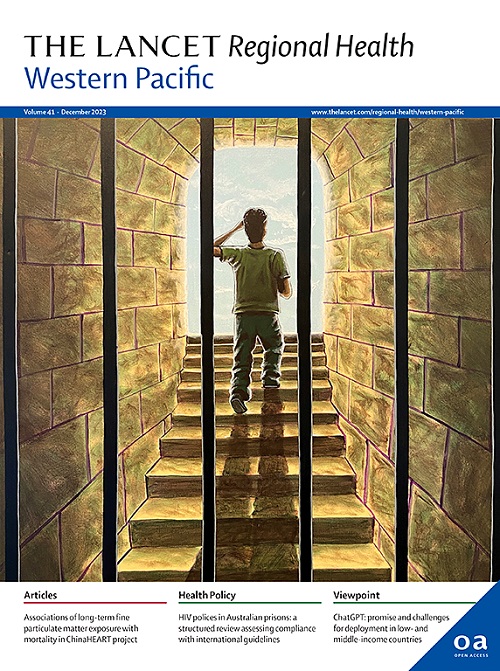Progress towards the UNAIDS 2030 HIV prevention target in New South Wales, Australia: a population-based study
IF 8.1
1区 医学
Q1 HEALTH CARE SCIENCES & SERVICES
引用次数: 0
Abstract
Background
The UNAIDS ending AIDS strategy includes a 2030 prevention target of a 90% reduction in new infections from 2010. We report progress towards this goal in gay, bisexual and other men who have sex with men (GBM) in New South Wales (NSW), Australia.
Methods
We report HIV notification data for people newly diagnosed by exposure category, with a focus on GBM who comprised more than three-quarters of diagnoses. We report HIV testing, pre-exposure prophylaxis, HIV treatment, and undetectable viral load based on surveys of community-based GBM and data from a sentinel surveillance network of 50 clinics. We report trends between 2010 and 2022, including by geography grouped by postcodes with high-, medium- and low-prevalence of gay residents. Trends were assessed using the chi-square test for linear trend.
Findings
Statewide, annual notifications declined by 56% in GBM, and declines were much greater in inner-Sydney postcodes with a high percentage of gay residents compared to postcodes with a low percentage (88% and 32%). Among community-recruited GBM, annual HIV testing and PrEP uptake increased over time and by 2022 were higher in the high- (91% and 82%) than low-gay prevalence postcodes (78% and 61%). In the clinic sample, HIV testing and PrEP use increased but there was no evidence that they differed by geography. In both samples, among GBM living with HIV, the percentages on HIV treatment and with undetectable viral load increased over time, and by 2022 were greater than 95%.
Interpretation
HIV notifications in GBM in NSW have dropped by more than half since 2010. In inner Sydney areas with a high prevalence of gay men, prevention uptake was highest, and the decline in notifications approached 90%. Declines in HIV notifications were more modest elsewhere, and prevention uptake lower. Currently available prevention interventions, if extended population-wide, can enable a 90% reduction in new HIV infections in GBM, consistent with the ending AIDS target.
Funding
This project was funded by the National Health and Medical Research Council and the NSW Ministry of Health.
在澳大利亚新南威尔士州实现联合国艾滋病规划署2030年艾滋病毒预防目标的进展:一项基于人口的研究
联合国艾滋病规划署终止艾滋病战略包括2030年的预防目标,即从2010年起将新感染减少90%。我们报告了澳大利亚新南威尔士州同性恋、双性恋和其他男男性行为者(GBM)在实现这一目标方面取得的进展。我们报告了按暴露类别新诊断的人的艾滋病毒通报数据,重点关注占诊断总数四分之三以上的GBM。我们报告了基于社区GBM调查和50个诊所哨点监测网络数据的HIV检测、暴露前预防、HIV治疗和无法检测到的病毒载量。我们报告了2010年至2022年间的趋势,包括按地理位置按邮政编码分组的同性恋居民高、中、低患病率。采用卡方检验对线性趋势进行评估。研究发现,在全州范围内,GBM的年度通报率下降了56%,在悉尼市内同性恋居民比例高的邮政编码地区,与比例低的邮政编码地区(88%和32%)相比,下降幅度更大。在社区招募的GBM中,年度艾滋病毒检测和PrEP使用率随着时间的推移而增加,到2022年,高同性恋患病率邮政编码(91%和82%)高于低同性恋患病率邮政编码(78%和61%)。在诊所样本中,艾滋病毒检测和PrEP的使用增加了,但没有证据表明它们因地理位置而不同。在这两个样本中,在感染艾滋病毒的GBM中,接受艾滋病毒治疗和无法检测到病毒载量的百分比随着时间的推移而增加,到2022年超过95%。自2010年以来,新南威尔士州GBM的艾滋病毒通报率下降了一半以上。在悉尼市内男同性恋者高发的地区,预防措施的使用率最高,通报率下降了近90%。其他地方艾滋病毒通报率的下降幅度较小,预防措施的接受程度也较低。目前可用的预防干预措施,如果在人口范围内推广,可使GBM中新发艾滋病毒感染减少90%,符合消除艾滋病的目标。该项目由国家卫生和医学研究委员会和新南威尔士州卫生部资助。
本文章由计算机程序翻译,如有差异,请以英文原文为准。
求助全文
约1分钟内获得全文
求助全文
来源期刊

The Lancet Regional Health: Western Pacific
Medicine-Pediatrics, Perinatology and Child Health
CiteScore
8.80
自引率
2.80%
发文量
305
审稿时长
11 weeks
期刊介绍:
The Lancet Regional Health – Western Pacific, a gold open access journal, is an integral part of The Lancet's global initiative advocating for healthcare quality and access worldwide. It aims to advance clinical practice and health policy in the Western Pacific region, contributing to enhanced health outcomes. The journal publishes high-quality original research shedding light on clinical practice and health policy in the region. It also includes reviews, commentaries, and opinion pieces covering diverse regional health topics, such as infectious diseases, non-communicable diseases, child and adolescent health, maternal and reproductive health, aging health, mental health, the health workforce and systems, and health policy.
 求助内容:
求助内容: 应助结果提醒方式:
应助结果提醒方式:


